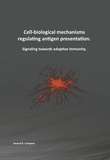Cell‐biological mechanisms regulating antigen presentation
Summary
We, humans, are exposed daily to millions of potential pathogens, through contact, inhalation, or ingestion. Our ability to avoid infection depends on our immune system, which consists of two distinct, yet interrelated and interacting subsystems: the innate and adaptive immune system. The adaptive immune system remembers previous encounters with specific pathogens and destroys them when they attack again. Elicitation of an adaptive response depends on special white blood cells from the innate immune system.
This thesis focuses on the central role that the intracelllular endosomal transport network in these specialized white blood cells, e.g. B-cells and Dendritic cells (DCs), plays in elicitating an adaptive immune response.
Using live cell fluorescent microscopy on human monocyte-derived DCs, we show that TLR-triggering induced tubulation of late endosomes. However, TLR triggering was insufficient to stimulate tubulation of endosomal recycling compartments (ERCs) in human monocyte-derived DCs. Tubulation of ERCs within human DCs required additional antigen-specific CD8+ T-cell interaction. This tubular remodeling occurs within 30 min of T-cell contact and involved ligation of HLA-A2 and ICAM-1 by Tcell-expressed T-cell receptor and LFA-1, respectively. In addition, we demonstrated that MICAL-L1 is necessary for tubulation of ERCs in human DCs. Disintegration of microtubules or inhibition of endosomal recycling abolished tubular ERCs, which coincided with reduced antigen-dependent CD8+ T-cell activation.
Another mechanism that is involved in endosomal trafficking and underlies antigen presentation, is receptor-mediated uptake of antigens. We targeted exogenous antigen to Fc gamma receptors (FcγRs), which increased CD8+ T-cell activation following antigen cross-presentation by human monocyte-derived and BDCA-3+ DCs. Using several pharmaceutical inhibitors, we show that FcγR-targeted antigens enter both cytosolic and vacuolar pathways of cross-presentation in human DCs.
Additionally, we report on two related Common Variable Immunodeficiency (CVID) patients carrying a Leucine to Proline replacement at position 3 in the Src kinase B-lymphoid tyrosine kinase (BLK). Unlike in mice, where functional redundancy exists between Src kinases, we show that L3P-BLK abrogates early B-cell Receptor (BCR) signalling, e.g. Syk phosphorylation, required for B-cell proliferation. Moreover, expression of L3P-BLK accelerates late endosomal/lysosomal BCR-antigen complex delivery, causing destruction of the antigen. Together these events reduce antigen presentation as shown by decreased BCR-mediated HLA-DR-restricted antigen-specific activation of CD4+ T-cells. Thus, defective early BCR signalling may affect endosomal trafficking and diminish interdependent antigen presentation. Whether more CVID patients harbour defective endosomal trafficking and antigen presentation is unknown to date, but we showed disturbed early BCR signalling in a significant proportion of pediatric CVID(-like) patients. In these young CVID-patients, BCR or CD20 crosslinking induces less BCR internalization and antibody-mediated CD20 triggering elicited decreased BCR downstream signaling as measured by secondary Ca2+ fluxes.
In conclusion, the work described in this thesis describes the pivotal role of the endosomal network in initiation of adaptive immune responses. Regulating key endosomal processes by interfering a.o. with endosomal tubulation, antigen (Fcγ) receptor-targeting, or Src kinase (BLK) function may contribute to an improvement in future therapeutic intervention strategies contributing to patient survival.
